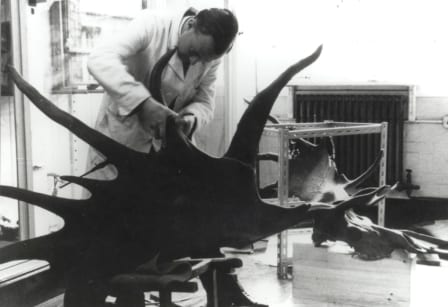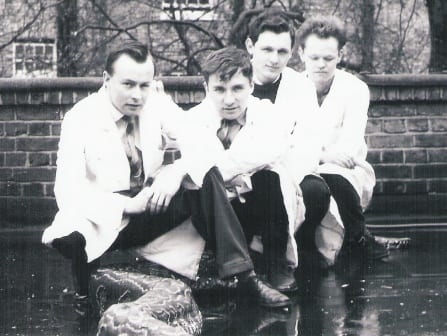On the Origin of Our Specimens: The Mahoney Years
By Emma-Louise Nicholls, on 3 April 2014
The collection of specimens, known since 1997 as the Grant Museum of Zoology, was started in 1827 by Robert E. Grant. Grant was the first professor of zoology at UCL when it opened, then called the University of London, and he stayed in post until his death in 1874. The collections have seen a total of 13 academics in the lineage of collections care throughout the 187 year history of the Grant Museum, from Robert E. Grant himself, through to our current Curator Mark Carnall.
Both Grant and many of his successors have expanded the collections according to their own interests, which makes for a fascinating historical account of the development of the Museums’ collections. This mini-series will look at each of The Thirteen in turn, starting with Grant himself, and giving examples where possible, of specimens that can be traced back to their time at UCL. Previous editions can be found here.
 Number Nine: Roy Mahoney (1956-1971)
Number Nine: Roy Mahoney (1956-1971)
Mahoney was born in Lancashire on 24th June 1929, but relocated with his family to Romford in Essex when he was five years old. He attended the Royal Liberty School for boys in Gidea Park until the age of 16, at which time he went straight into employment. He got a job at the British Drug House in Islington, now known as VWR. Whilst at the BDH in the 1940s, Mahoney worked with rabbits that were injected with batches of medical products to test for any trace of pyrogens, which cause fever and could prove fatal to sick patients. If the effects of pyrogens were detected, the batch was rejected. Mahoney told me that all of the rabbits had names and were well loved by the staff, nor were they harmed by the injections.
During his time at the BDH, Mahoney met a gentleman who was working on testing biological dyes, and it was at this point that Mahoney’s interest, and training, in histology began. In 1951, the British Drug House moved to Poole which Mahoney decided was not for him, and so he came to UCL as a technician. A job that required his skills as a histologist. At the time, his post was called ‘college servant’. Mahoney worked under the then curator, Reg Harris, and helped to care for the collections. Mahoney was appointed curator when Harris moved to the Natural History Museum (the then British Museum (Natural History)), in 1956. Mahoney was supported by a group of museum technicians, including Edwin Perry, Michael Lawrence and John Ferguson, and seems to have spent the majority of his time setting up the teaching labs, or practicals as we could call them now.
When UCL got a transmission electronic microscope, Mahoney was put in charge of it. This began to take so much of his time up, that in 1971, he relinquished his position as curator in order to lighten his workload. His technician Michael Lawrence, mentioned above, took over as curator. Mahoney began to look after the finances of the department, which led to him having to regrettably give up his technical work. Despite a move into an area that he was less passionate about, Mahoney stayed at UCL for the remainder of his working life, until his retirement in around 1994.
Whilst at the Grant Museum, both as technician to Reg Harris and as curator himself, Mahoney worked with thin sections. He would stain specimens and mount them on to slides. A group of specimens that Mahoney specifically remembers preparing was a series of thin sections of a sea gooseberry, or Pleurobranchia. He also recalled preparing serial sections of the tail of the African clawed frog, from when the tail started to grow, to when it regressed and disappeared.
 Mahoney also worked on much larger specimens within the collections, such as the giant deer cranium and antlers. They came to the Museum in 1961 whilst Mahoney was curator. A UCL biologist was on a trip to Ireland when the skull and antlers of an extinct giant deer were spotted hanging on the wall of a hotel in County Kildare. Recognising their importance, the staff member offered to buy them and thus the specimen was acquired for the Museum. The image to the left shows Mahoney reattaching one of the great tines of the right antler. If you look closely at the specimen on display in the Museum today, you can see the join where it was fixed by Mahoney. During a visit to the Museum by eminent biologist Stephen Jay Gould, he reportedly said that these antlers were the largest in Britain.
Mahoney also worked on much larger specimens within the collections, such as the giant deer cranium and antlers. They came to the Museum in 1961 whilst Mahoney was curator. A UCL biologist was on a trip to Ireland when the skull and antlers of an extinct giant deer were spotted hanging on the wall of a hotel in County Kildare. Recognising their importance, the staff member offered to buy them and thus the specimen was acquired for the Museum. The image to the left shows Mahoney reattaching one of the great tines of the right antler. If you look closely at the specimen on display in the Museum today, you can see the join where it was fixed by Mahoney. During a visit to the Museum by eminent biologist Stephen Jay Gould, he reportedly said that these antlers were the largest in Britain.
 The ‘anaconda’ in this image has been a recent source of much debate. The specimen was on display in London Zoo until it died in the 1960s at which point Mahoney received a phone call from the zoo asking if he wanted it for the Museum. Mahoney agreed and the specimen was taken to the roof of the Medawar building to be prepped for display. Mahoney recalled that he would have liked to have kept the skin, but the snake arrived in a bit of a sorry state and so it had to be discarded. In order to deal with the huge size of the animal, the snake was cut into pieces and Mahoney and his technicians (shown here on the right) had a section each to prep. The specimen is still on display at the Museum over 50 years later and is one of our top ten specimens. The debate that I referred to is over the actual identification of the snake as it seems that, despite Mahoney recalling being told that it was an anaconda, it is actually more likely to be a rock python. The intriguing mystery surrounding this specimen is outlined here.
The ‘anaconda’ in this image has been a recent source of much debate. The specimen was on display in London Zoo until it died in the 1960s at which point Mahoney received a phone call from the zoo asking if he wanted it for the Museum. Mahoney agreed and the specimen was taken to the roof of the Medawar building to be prepped for display. Mahoney recalled that he would have liked to have kept the skin, but the snake arrived in a bit of a sorry state and so it had to be discarded. In order to deal with the huge size of the animal, the snake was cut into pieces and Mahoney and his technicians (shown here on the right) had a section each to prep. The specimen is still on display at the Museum over 50 years later and is one of our top ten specimens. The debate that I referred to is over the actual identification of the snake as it seems that, despite Mahoney recalling being told that it was an anaconda, it is actually more likely to be a rock python. The intriguing mystery surrounding this specimen is outlined here.
Emma-Louise Nicholls is the Curatorial Assistant at the Grant Museum of Zoology
[UPDATE: Whilst researching this blog series, it was discovered that there had been an extra curator for a few months, following Roy Mahoney. As such, The Twelve became The Thirteen. As the aim of this series is to serve as a permanent record of our history, this and all subsequent blogs have been updated to reflect this exciting discovery.]
2 Responses to “On the Origin of Our Specimens: The Mahoney Years”
- 1
-
2
From the Archives: A Camel Head from London Zoo | UCL UCL Museums & Collections Blog wrote on 8 October 2014:

[…] according to the specimen label under and these photos were taken by former Grant museum curator Roy Mahoney. In the past the museum was equipped with a range of preparation facilities and included live […]
 Close
Close



[…] Edwin Perry and John Ferguson were on the museum staff as technicians. As mentioned in the ninth blog in the series, in the early 1970s UCL acquired a transmission electron microscope which Mahoney […]